Key takeaways:
- Follow-ups demonstrate commitment and can significantly enhance professional relationships, showing you value others’ time and input.
- Identifying timely follow-up moments—such as after meetings, project milestones, or networking events—can increase engagement and opportunities.
- Crafting personalized and clear follow-up messages, expressing appreciation, and including a call to action are essential for effective communication.
- Measuring follow-up success through metrics like response rates and long-term outcomes helps refine strategies and boosts confidence in relationship nurturing.
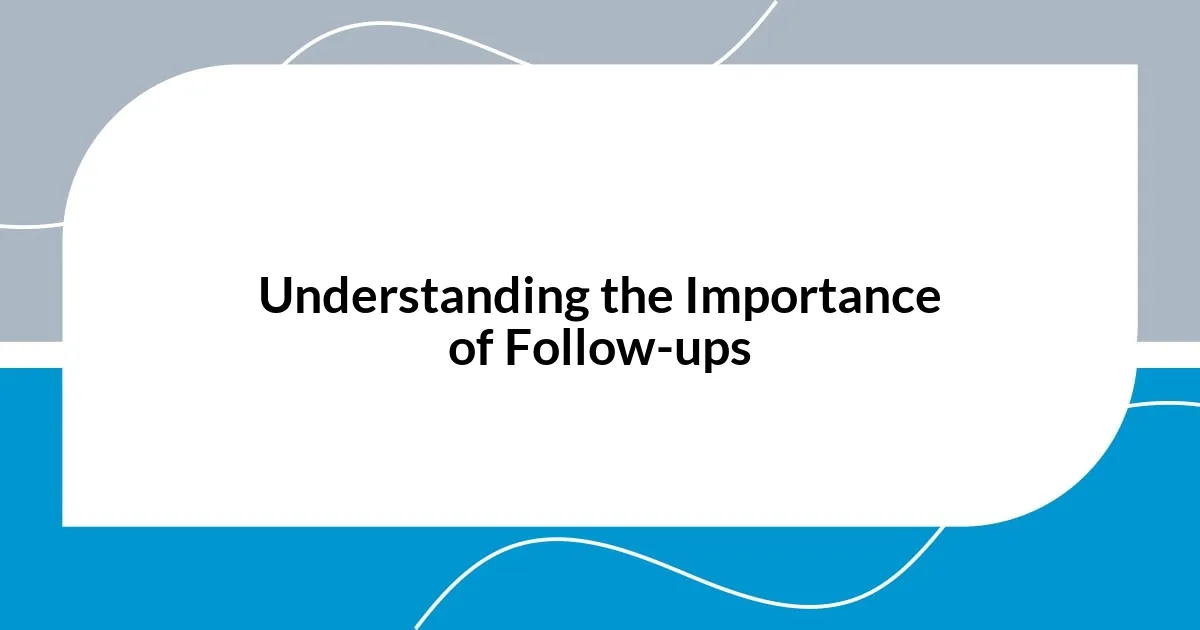
Understanding the Importance of Follow-ups
Follow-ups are essential because they show your commitment to ongoing communication. I remember a time when I landed a significant project simply because I checked in with a client after our initial meeting. That small act of follow-up not only reinforced my professionalism but also demonstrated my genuine interest in their needs.
I’ve often wondered why some people view follow-ups as an afterthought. In my experience, they can be the turning point in a professional relationship. When you reach out, you signal that you value the other person’s time and input. It fosters trust and sets the stage for future interactions—something I’ve seen pay off time and again.
Consider this: how many opportunities have slipped through your fingers due to a lack of follow-up? I’ve learned that even a quick message can reignite interest, clarify misunderstandings, and allow for dialogue. Each follow-up is a chance to build bridges, and I’ve found that those who consistently engage often reap the rewards of stronger connections and fruitful collaborations.
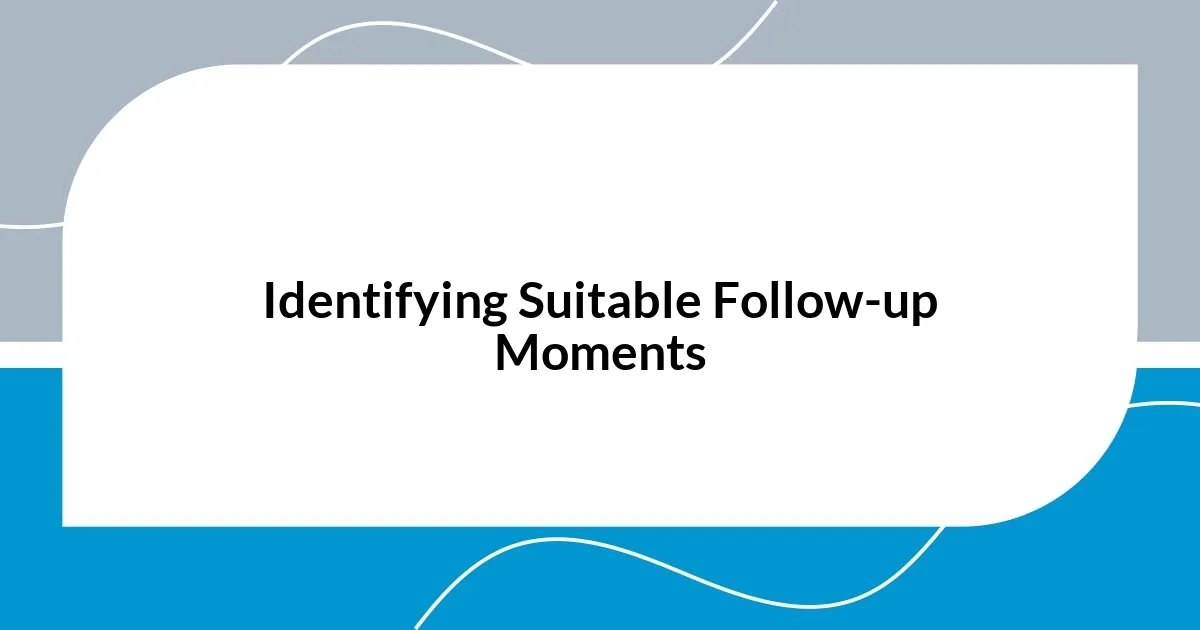
Identifying Suitable Follow-up Moments
Identifying the right moments to follow up can be a game changer in nurturing relationships. I remember an instance where I sent a follow-up email just three days after a networking event. The connection I fostered during that brief encounter blossomed into a collaborative project. Timing in follow-ups can significantly impact your chances of engagement, and it’s crucial to strike while the iron is hot.
One effective approach I’ve found is to listen to the cues during conversations. If someone mentions a timeline or a decision-making process, make a note of it. For example, I had a potential client who hinted that they were assessing options in two weeks. I followed up right on time, catching them when they were ready to make a choice. Being attentive to such signals opens doors to seamless communication.
I often assess follow-up moments during key milestones. Say, after delivering a proposal or completing an important meeting, it’s the perfect time to connect. Following up then shows you’re invested in the outcome and eager for feedback. I can’t recall how many times this has led to crucial conversations that moved projects forward, reinforcing the idea that timing can enrich our professional dealings.
| Follow-up Moment | Ideal Timing |
|---|---|
| Post-Meeting Reflection | 1-3 days after |
| Project Milestone | Immediately after completion |
| Networking Event | Within a week |
| Decision Timeline Mentioned | As noted by the contact |
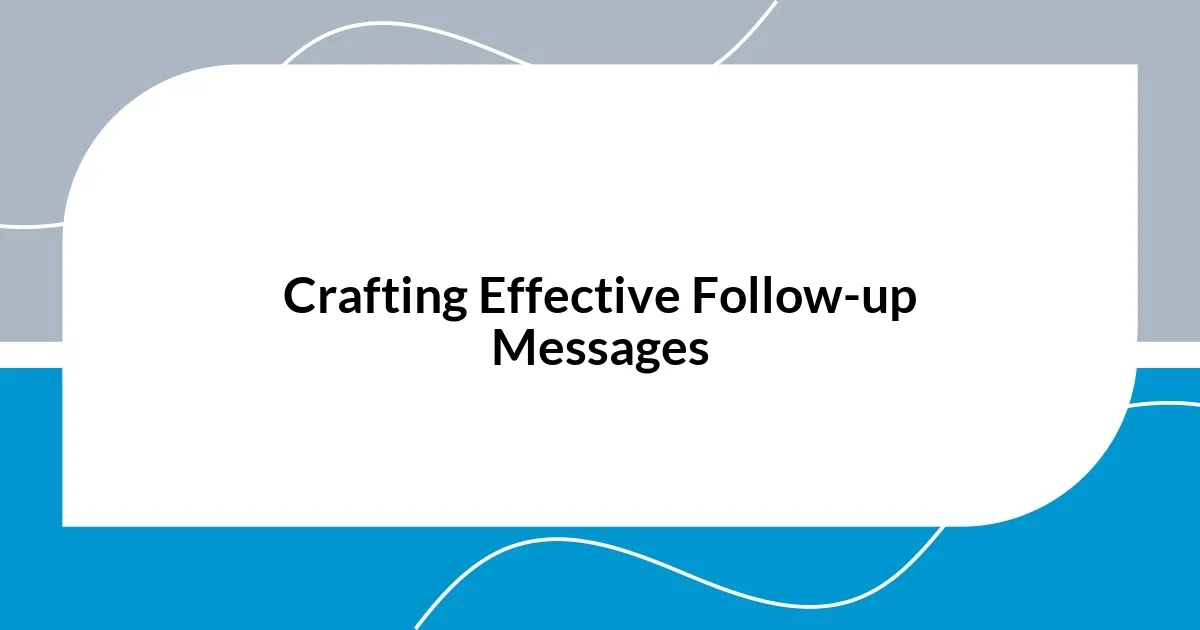
Crafting Effective Follow-up Messages
Crafting follow-up messages is an art that hinges on clarity and sincerity. I once sent a follow-up note to a prospective collaborator, thanking them for their insights and reiterating my excitement about the potential project. That message led to an unexpected discussion about creative ideas, turning a simple follow-up into a brainstorming session. The magic lies in being personable and specific—addressing what was discussed previously can make the recipient feel valued and engaged.
To ensure your follow-up messages hit the mark, consider these key strategies:
- Be Prompt: Aim to send your message within a few days to maintain momentum.
- Personalize Your Message: Reference past conversations or shared experiences to create a connection.
- Stay Clear and Concise: Clearly state your purpose and what you hope to achieve with the follow-up.
- Express Appreciation: Thank them for their time or insights to foster goodwill.
- Include a Call to Action: Invite them to respond or propose a next step, driving the conversation forward.
Crafting effective follow-up messages can turn a fleeting connection into a lasting collaboration. It’s a skill worth honing!
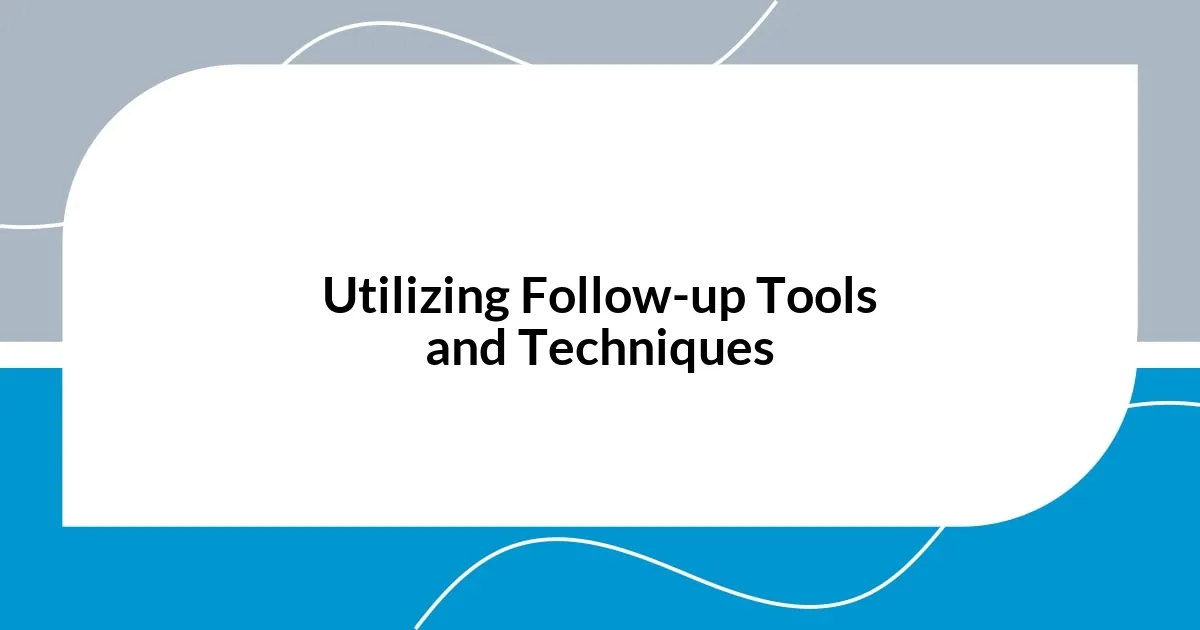
Utilizing Follow-up Tools and Techniques
Utilizing follow-up tools has truly transformed the way I manage my professional relationships. For instance, I’ve started using CRM (Customer Relationship Management) software to track interactions. I remember when I first adopted this tool; it felt like I suddenly had a superpower! Having the ability to see past communications and reminders at my fingertips made it much easier to engage with contacts at strategic moments.
There’s something rewarding about using automation for follow-ups. I use email scheduling features to send messages at optimal times, like Friday afternoons or early on Monday mornings. One time, I scheduled a follow-up message to go out just after a significant holiday—a bold choice, I know! It just so happened that the recipient appreciated the timely nudge and responded with enthusiasm, which opened up an exciting discussion about collaboration.
I can’t overstate the importance of keeping things organized. Creating follow-up checklists not only keeps me on track but also ensures I don’t miss opportunities. I once jotted down reminders after attending a webinar, and those notes led me to follow up with a speaker. That simple act resulted in a mentorship that has been invaluable to my career growth. Have you ever felt your notes were a lifeline to making connections? I certainly have!
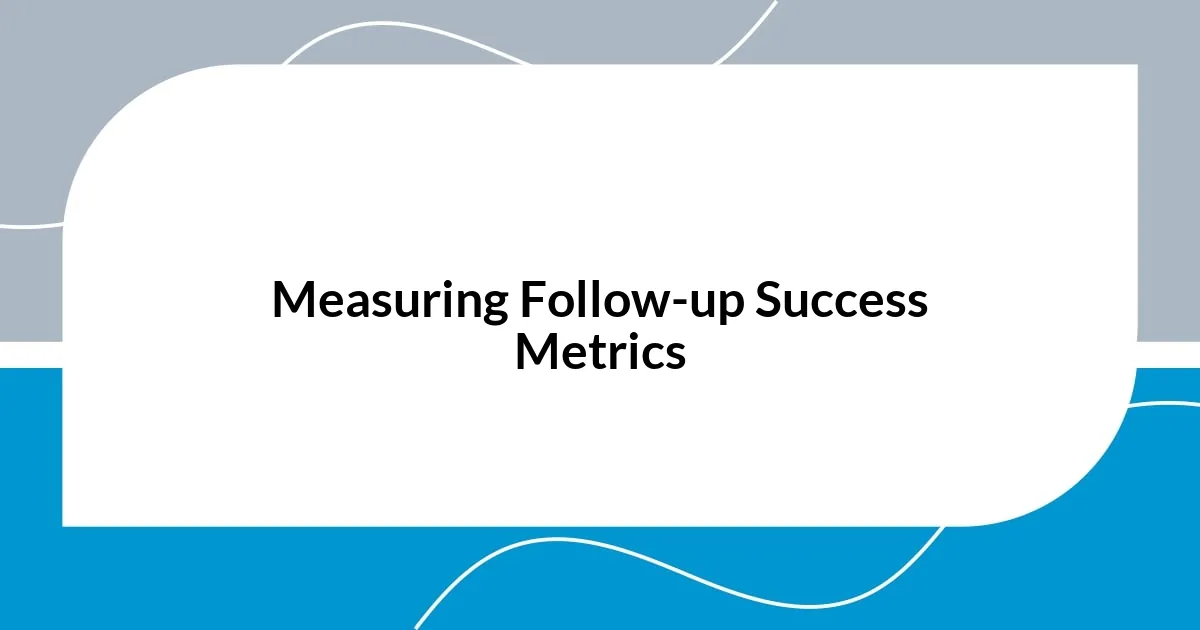
Measuring Follow-up Success Metrics
Measuring the success of my follow-ups has become an essential part of my strategy. I remember a time when I had a series of follow-ups with a potential client, and I tracked responses with a simple spreadsheet. The insights I gained were eye-opening! Each time I followed up, I noted their engagement level—did they open my email? Did they reply promptly? This approach not only helped me gauge interest but also allowed me to adjust my strategy based on their behavior.
One metric I often consider is the response rate. When I started analyzing this aspect, I realized that certain phrases in my follow-up messages elicited stronger replies. For instance, using a question in my subject line seemed to ignite interest more than a standard greeting. Have you ever wondered what small tweaks could amplify your engagement? I sure did, and tracking these details transformed how I approached communication.
Ultimately, I look at the long-term outcomes as well, like whether a follow-up led to a new opportunity or collaboration. Recently, a follow-up I initiated three months ago finally paid off when the recipient reached out about a project. It reminded me that sometimes, patience is key to measuring success. Understanding these metrics not only helps in refining my follow-up techniques but also builds confidence in nurturing professional relationships.
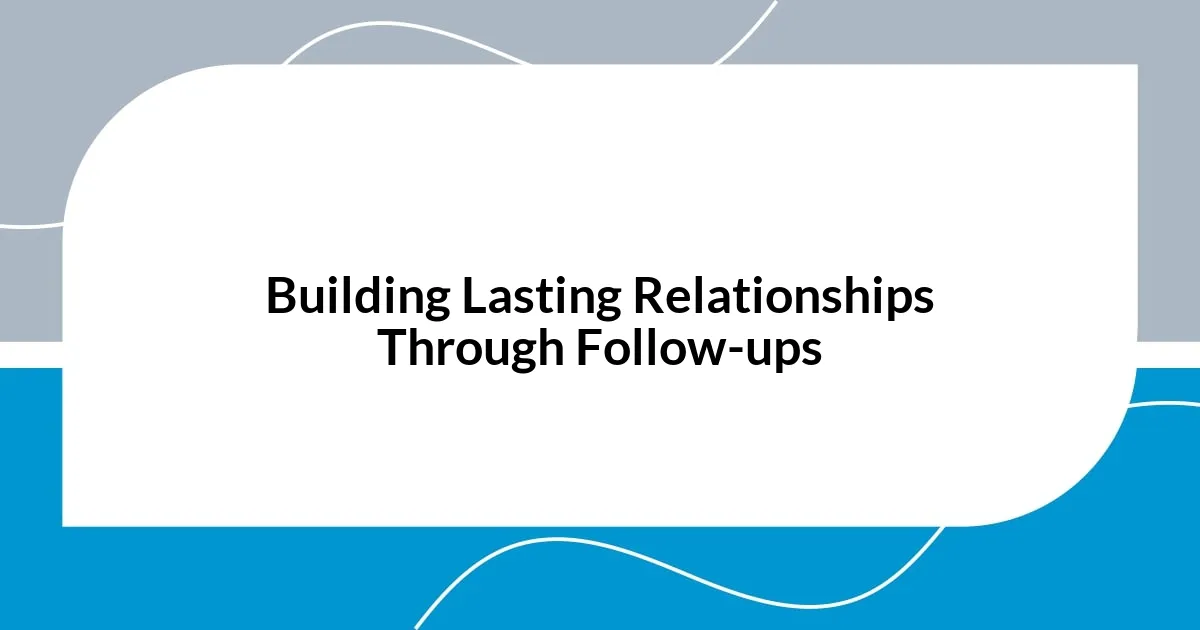
Building Lasting Relationships Through Follow-ups
Building lasting relationships through follow-ups is an art that I’ve come to appreciate deeply. I recall a time when I sent a casual message to an old colleague just to check in. To my surprise, that brief interaction led to a full-blown discussion about an upcoming project, and it turned out we had synergies that neither of us had realized. There’s something powerful about those simple outreach moments, don’t you think? They can inspire connections that lead to exciting collaborations.
Another memorable instance was when I decided to follow up with a potential client several weeks after our initial meeting. Instead of a standard reminder, I shared an article that aligned with our conversation. This thoughtful gesture not only rekindled their interest but also positioned me as someone genuinely invested in our potential relationship. Isn’t it amazing how a bit of thoughtfulness can turn an ordinary follow-up into something that truly resonates?
Ultimately, I believe that these follow-ups act as the glue that bonds relationships over time. Each interaction builds trust and demonstrates my commitment to nurturing these connections. When I reflect on my journey, I realize that every follow-up has left a lasting impression, and relating to others through these continued conversations enriches my professional life immeasurably.